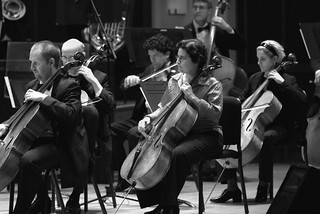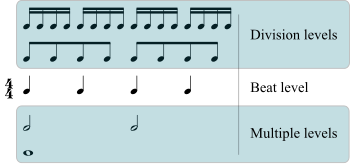Musical Terms and Concepts
Explanations and musical examples can be found through the Oxford Music Online, accessed through the Potsdam Library page at http://potsdam.libguides.com/music. Click on Music Reference, then Oxford Music Online.
Originally from http://www.potsdam.edu/academics/Crane/MusicTheory/Musical-Terms-and-Concepts.cfm
Key terms and concepts
disjunct: melodic motion in intervals larger than a 2nd, often with a large number of wide skips
(> octave) or wide (< octave)
motive: a short pattern of 3-5 notes (melodic, rhythmic, harmonic or any combination of these) that is repetitive
in a composition
phrase: a musical unit with a terminal point, or cadence. Lengths of phrases can vary.
measures or bars: a metrical unit separated by lines in musical notation
meter: groups of beats in a recurring pattern with accentuation on strong beats
non-metric, unmetrical: free rhythm, no discernable time
simple meters: beats subdivided into two parts (2/4, 3/4, 4/4)
compound meters: beats subdivided into three parts (6/8, 9/8, 12/8)
asymmetrical meters: meters with an uneven number of subdivisions (7/4, 5/8)
mixed meters: shifting between meters
mensurations: used in music from 1300-1600, the ratios of rhythmic durations
triads: three notes that can be arranged into superimposed thirds
extended chords: thirds added above the triad, usually as a 9th, 11th or 13th
consonance: a harmonic combination that is stable, usually in thirds
dissonance: a harmonic combination that is unstable, often including seconds or sevenths
parallel motion: two or more parts moving in the same direction and same intervals, as in parallel fifths
contrary motion: two or more parts moving in the opposite direction
oblique motion: occurs when one voice remains on a single pitch while the other ascends or descends
canon: (meaning rule) one melody is strictly imitated by a second part after a delay in the entrance of the
second part. In order for the parts to end simultaneously, the canon may break down at the end of the
composition. The canonic parts may occur at the unison or some other interval.
round: an exact canon, ending at different times, as in “Row, row, row your boat.”
imitation: two or more parts that have the same or similar phrase beginning and with delays between
entrances (as in a round or canon), but after the beginning of the phrase, the parts diverge into separate
melodies
within this type of scale.
chromatic: using pitches outside of a particular diatonic scale, or using a succession of half steps.
major tonality: pitches are related to a central pitch called the tonic. Major scales are used.
minor tonality: pitches are related to a central pitch called the tonic. Minor scales are used.
modal: refers to music using diatonic scales with Greek names (Western) or non-Western scales
modulation: moving from one key area to another key
atonality: music that is not tonal or not based on any system of keys or modes
bitonality: the simultaneous use of two key areas.
polytonality: the simultaneous use of two or more key areas.
without harmony or any accompaniment, which can occur when one person or many people sing a
melody simultaneously. Singing in octaves is considered a monophonic texture.
homophony (noun; homophonic = adjective): one melodic line with a harmonic accompaniment that supports
the melody.
polyphony (noun; polyphonic = adjective): two or more parts sung or played simultaneously.
heterophony (noun; heterophonic = adjective): multiple voices singing a single melodic line, but with
simultaneous melodic variants between the singers. Heterophony often occurs in non-Western music and
sometimes in folk music.
Key terms and concepts
Related to melody:
contour: the shape of the melody as rising or falling
conjunct: stepwise melodic motion, moving mostly by step in intervals of a 2nddisjunct: melodic motion in intervals larger than a 2nd, often with a large number of wide skips
(> octave) or wide (< octave)
motive: a short pattern of 3-5 notes (melodic, rhythmic, harmonic or any combination of these) that is repetitive
in a composition
phrase: a musical unit with a terminal point, or cadence. Lengths of phrases can vary.
| English: Simple demonstration of metric levels in 4-4 time (Photo credit: Wikipedia) |
Related to rhythm:
beat: pulsemeasures or bars: a metrical unit separated by lines in musical notation
meter: groups of beats in a recurring pattern with accentuation on strong beats
non-metric, unmetrical: free rhythm, no discernable time
simple meters: beats subdivided into two parts (2/4, 3/4, 4/4)
compound meters: beats subdivided into three parts (6/8, 9/8, 12/8)
asymmetrical meters: meters with an uneven number of subdivisions (7/4, 5/8)
| Simple (quad)duple drum pattern: divides two beats into two About this sound Play ( help · info ) (Photo credit: Wikipedia) |
mensurations: used in music from 1300-1600, the ratios of rhythmic durations
Related to harmony:
chords: three or more pitches sounding simultaneouslytriads: three notes that can be arranged into superimposed thirds
extended chords: thirds added above the triad, usually as a 9th, 11th or 13th
consonance: a harmonic combination that is stable, usually in thirds
dissonance: a harmonic combination that is unstable, often including seconds or sevenths
parallel motion: two or more parts moving in the same direction and same intervals, as in parallel fifths
contrary motion: two or more parts moving in the opposite direction
oblique motion: occurs when one voice remains on a single pitch while the other ascends or descends
| The intervals contained in the table are diatonic to C major. All other intervals are chromatic to C major. (Photo credit: Wikipedia) |
second part. In order for the parts to end simultaneously, the canon may break down at the end of the
composition. The canonic parts may occur at the unison or some other interval.
round: an exact canon, ending at different times, as in “Row, row, row your boat.”
imitation: two or more parts that have the same or similar phrase beginning and with delays between
entrances (as in a round or canon), but after the beginning of the phrase, the parts diverge into separate
melodies
Related to tonality:
diatonic: a seven-note scale with a regular pattern of 5 whole and 2 half steps. Diatonic intervals are foundwithin this type of scale.
chromatic: using pitches outside of a particular diatonic scale, or using a succession of half steps.
major tonality: pitches are related to a central pitch called the tonic. Major scales are used.
minor tonality: pitches are related to a central pitch called the tonic. Minor scales are used.
modal: refers to music using diatonic scales with Greek names (Western) or non-Western scales
modulation: moving from one key area to another key
atonality: music that is not tonal or not based on any system of keys or modes
bitonality: the simultaneous use of two key areas.
polytonality: the simultaneous use of two or more key areas.
Related to texture:
monophony (noun; monophonic = adjective, as in monophonic texture): literally “one sound” - one melodic line,without harmony or any accompaniment, which can occur when one person or many people sing a
melody simultaneously. Singing in octaves is considered a monophonic texture.
homophony (noun; homophonic = adjective): one melodic line with a harmonic accompaniment that supports
the melody.
polyphony (noun; polyphonic = adjective): two or more parts sung or played simultaneously.
heterophony (noun; heterophonic = adjective): multiple voices singing a single melodic line, but with
simultaneous melodic variants between the singers. Heterophony often occurs in non-Western music and
sometimes in folk music.
homorhythms: the same rhythms in all parts, as in the singing of a hymn.
counterpoint (noun; contrapuntal = adjective): like polyphony in that it has two or more compatible melodies
performed simultaneously.
aerophones: wind produces the sound (woodwinds and brass instruments)
membranophone: a vibrating membrane produces the sound (drums)
idiophone: sound is produced from the material (wood, glass, stone, metal)
melismatic: one syllable sung to several notes
sacred: religious music, often for the church liturgy (services)
secular: worldly, non-religious music, usually in the vernacular
vernacular: texts in the language of the people (English, French, Spanish, German, etc.)
Related to musical forms:
Generally capital letters are used to distinguish different sections of a composition. A capital refers to an exact repetition. A lowercase letter refers to the same music but new text. A prime number after the capital refers to a variation of the music from the original section.
repetitive forms:
strophic: a vocal form consisting of several phrases. The musical form is repeated using different verses
of text, as in a hymn or folksong.
modified strophic: simply means that the repetitions of the sections are varied slightly, but not so much
that they are a significant variation or the original.
bar form: two sections of music, with only the first section A repeated. Many hymns use the far form.
binary form: two sections of music, usually with each A and B section repeated. This is typically used in
dances. When a group dances are combined into a suite, the dances generally all stay in the same key.
counterpoint (noun; contrapuntal = adjective): like polyphony in that it has two or more compatible melodies
performed simultaneously.
Releated to timbre: classifications of instruments
chordophone: string instrumentsaerophones: wind produces the sound (woodwinds and brass instruments)
membranophone: a vibrating membrane produces the sound (drums)
idiophone: sound is produced from the material (wood, glass, stone, metal)
Related to text and music:
syllabic: one syllable sung to each notemelismatic: one syllable sung to several notes
sacred: religious music, often for the church liturgy (services)
secular: worldly, non-religious music, usually in the vernacular
vernacular: texts in the language of the people (English, French, Spanish, German, etc.)
Related to musical forms:
Generally capital letters are used to distinguish different sections of a composition. A capital refers to an exact repetition. A lowercase letter refers to the same music but new text. A prime number after the capital refers to a variation of the music from the original section.
repetitive forms:
strophic: a vocal form consisting of several phrases. The musical form is repeated using different verses
of text, as in a hymn or folksong.
modified strophic: simply means that the repetitions of the sections are varied slightly, but not so much
that they are a significant variation or the original.
bar form: two sections of music, with only the first section A repeated. Many hymns use the far form.
binary form: two sections of music, usually with each A and B section repeated. This is typically used in
dances. When a group dances are combined into a suite, the dances generally all stay in the same key.
processive forms: variation forms:
continuous variations: includes an ostinato -- a repeated bass line or set of chords (usually 4-8 measures)
with continuous variations above the bass pattern. This term is also called a ground bass, a chaconne,
and a passacaglia. These are common in the Renaissance and Baroque periods.
with continuous variations above the bass pattern. This term is also called a ground bass, a chaconne,
and a passacaglia. These are common in the Renaissance and Baroque periods.
sectional variations: a theme and variation set, where usually each section is clearly marked. Generally
in a theme and variations, the theme itself is identifiable. Variation sets are commonly used in the Classical
period as the slow movement of a string quartet or symphony.
in a theme and variations, the theme itself is identifiable. Variation sets are commonly used in the Classical
period as the slow movement of a string quartet or symphony.
fugue: a one-subject (also called monothematic) composition in which the subject is continually restated on
different pitches and in various keys, processing the modulations, fragments or registers of the subject.
Like the other variation forms, there is usually a return to the subject in the original key.















